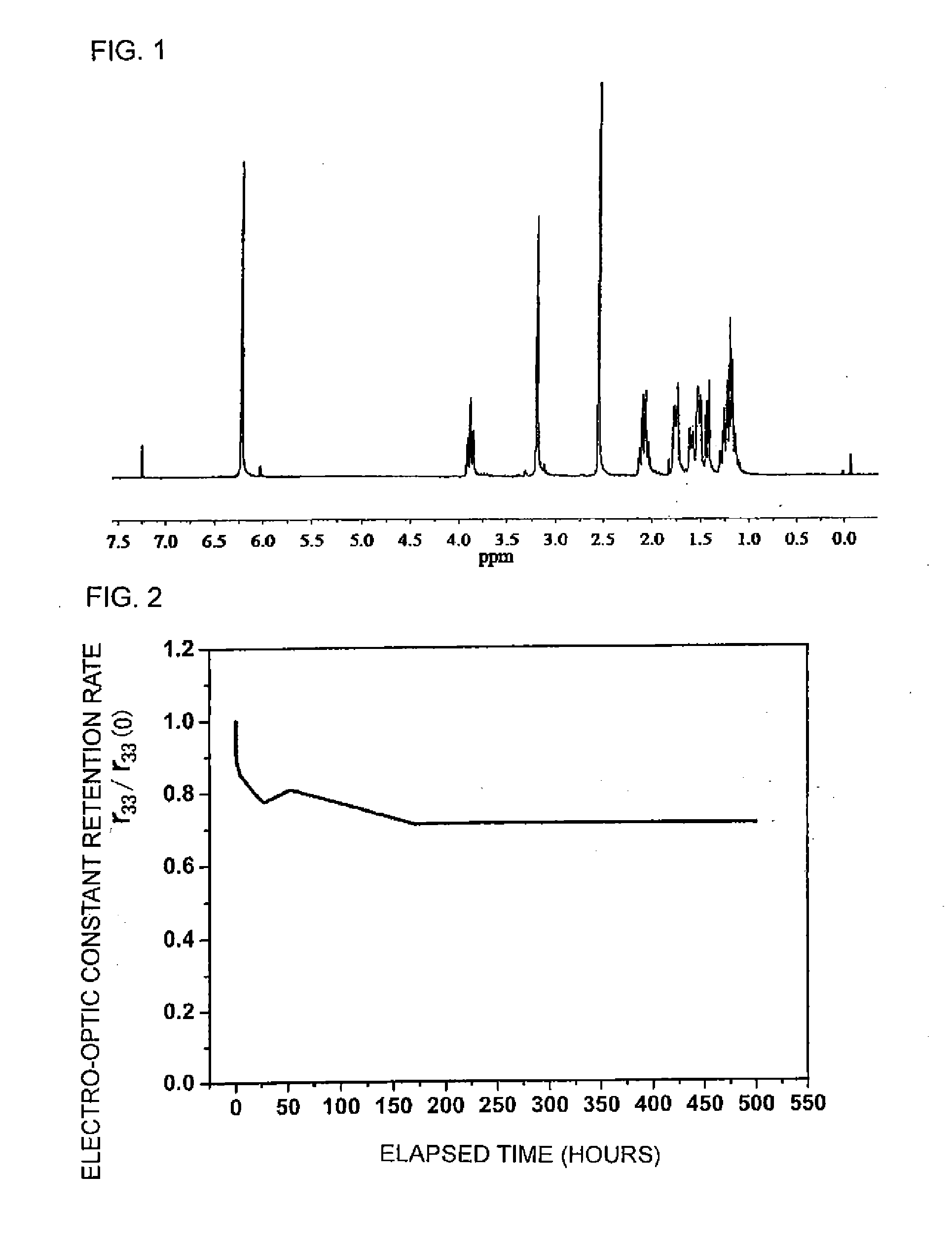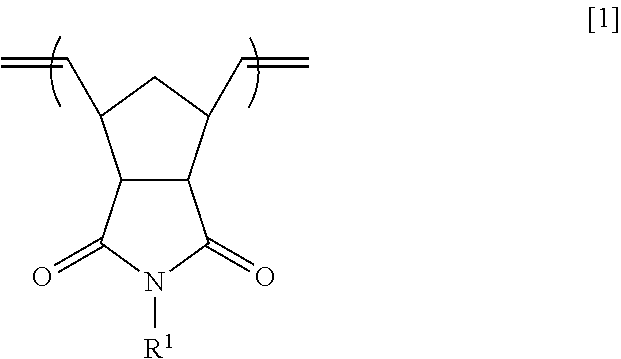Polymer composition containing organic nonlinear optical compound
a nonlinear optical compound and polymer composition technology, applied in the field of polymer compositions containing organic nonlinear optical compounds, can solve the problems of difficult dispersion of molecules in poly, deterioration of compound characteristics, and poor compatibility between polymer matrix and nonlinear optical compounds such as dr1, and achieves easy formability, high handling ability, and easy formation
- Summary
- Abstract
- Description
- Claims
- Application Information
AI Technical Summary
Benefits of technology
Problems solved by technology
Method used
Image
Examples
synthesis example 1
Synthesis of Exo-norbornene-5,6-dicarboxylic anhydride[7]
[0121]
[0122]94.1 g (0.96 mol) of maleic anhydride [manufactured by Tokyo Chemical Industry Co., Ltd.] was dissolved into 100 mL of o-dichlorobenzene. 63.4 g (0.48 mol) of dicyclopentadiene [manufactured by Tokyo Chemical Industry Co., Ltd.] was added dropwise to the resultant solution at 173° C. Subsequently, this solution was refluxed at 183° C. for 1.5 hours and then was cooled down to room temperature. After the completion of the reaction, the reaction solution was left to stand overnight to precipitate crystals. Thus obtained grayish white solid was isolated through filtration under reduced pressure. The resultant compound was recrystallized from chlorobenzene twice.
[0123]The resultant compound was a mixture of an endo form and an exo form. The compound was heated at 250° C. under nitrogen atmosphere for 1 hour and was isomerized from the endo form to the exo form. The resultant compound was cooled down to 120° C. Chlorobe...
synthesis example 2
Synthesis of n-Cyclohexylamine Acid [8]
[0124]
[0125]100 g (0.61 mol) of the exo-norbornene-5,6-dicarboxylic anhydride produced in Synthesis Example 1 was dissolved in 200 mL of toluene. While the resultant solution was stirred, 60.9 g (0.61 mol) of cyclohexylamine [manufactured by Tokyo Chemical Industry Co., Ltd.] was added dropwise to the solution, and the resultant mixture was heated at 50° C. for 1 hour. Precipitation occurred 20 minutes later, and the viscosity of the solution increased due to the formed precipitate, and thus, toluene was added in a small amount. The precipitate was then filtrated, and the residue was washed with extra toluene to produce an n-cyclohexylamine acid (yield: 72%).
synthesis example 3
Synthesis of N-Cyclohexyl-exo-norbornene-5,6-dicarboximide[9]
[0126]
[0127]26.6 g (0.10 mol) of the n-cyclohexylamine acid produced in Synthesis Example 2 and 4.7 g (57 mmol) of sodium acetate anhydrous [manufactured by KANTO CHEMICAL CO., INC] were dissolved in 94.3 g (0.92 mol) of acetic anhydride [manufactured by KANTO CHEMICAL CO., INC]. The resultant solution was refluxed at 140° C. for 2 hours. The resultant reaction solution was then put in a freezer for complete solidification.
[0128]The solid, as filtrated and was washed with ion-exchanged water in an excess amount. The water phase of the filtrate was subjected to extraction with chloroform, and the solvent was distilled off. The resultant solid was combined with the filtrated solid. The grayish white solid was dried overnight under reduced pressure at 60° C. Subsequently, the solid was recrystallized from methanol several times until it turned white to produce N-cyclohexyl-exo-norbornene-5,6-dicarboximide (yield: 65%). The pr...
PUM
| Property | Measurement | Unit |
|---|---|---|
| glass transition temperature | aaaaa | aaaaa |
| molar ratio | aaaaa | aaaaa |
| temperature | aaaaa | aaaaa |
Abstract
Description
Claims
Application Information
 Login to View More
Login to View More - R&D
- Intellectual Property
- Life Sciences
- Materials
- Tech Scout
- Unparalleled Data Quality
- Higher Quality Content
- 60% Fewer Hallucinations
Browse by: Latest US Patents, China's latest patents, Technical Efficacy Thesaurus, Application Domain, Technology Topic, Popular Technical Reports.
© 2025 PatSnap. All rights reserved.Legal|Privacy policy|Modern Slavery Act Transparency Statement|Sitemap|About US| Contact US: help@patsnap.com



